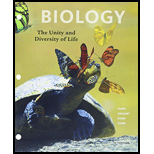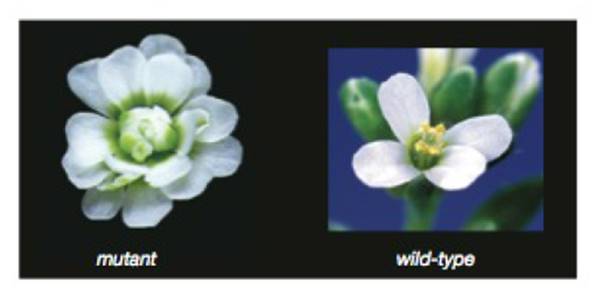
Bundle: Biology: The Unity and Diversity of Life, Loose-leaf Version, 14th + MindTap Biology, 2 terms (12 months) Printed Access Card
14th Edition
ISBN: 9781305616714
Author: Cecie Starr, Ralph Taggart, Christine Evers, Lisa Starr
Publisher: Cengage Learning
expand_more
expand_more
format_list_bulleted
Textbook Question
Chapter 10, Problem 4CT

The photos above show flowers from Arabidopsis plants. One plant is wild-type (unmutated); the other carries a mutation in one of its ABC floral identity genes. This mutation causes sepals and petals to form instead of stamens and carpels. Refer to Figure 10.8 to decide which gene (A, B, or C) has been inactivated by the mutation.
Expert Solution & Answer
Want to see the full answer?
Check out a sample textbook solution
Students have asked these similar questions
You conduct an experiment to study the expression of the S protein through the
tissues of your favorite plant (Arabidopsis thaliana). The morning of the experiment
you inject in the leaves a messenger RNA that codes for the synthesis of a single
protein made of two parts that are attached to each other: the functional S protein
and a red fluorescent protein tag (RFP). You perform two cross sections of the same
root, one section at the start of the experiment (time = Oh; corresponding to the time
of injection) and one section in the afternoon (time = 8h). Through fluorescent
microscopy you observe a change in the coloration inside the cells of the root's
central tissues (as indicated by the arrows): from no coloration (time = Oh) to red
(time = 8h).
• The cells of the central tissues in the roots do not have nuclei or ribosomes.
How can you explain this change of coloration? Please provide a cellular
feature that can lead to this.
• What is one advantage of using an RFP-tag in an mRNA?…
In roses, the synthesis of red pigment is produced by two steps in a pathway.
gene O
magenta intermediate -
gene P
colorless intermediate-
red pigment
What would the phenotype be of a plant homozygous for a null mutation of gene P?
What would the phenotype be of a plant homozygous for a null mutation of gene Q?
What would the phenotype be of a plant homozygous for null mutations of genes P and Q?
magenta
red
Match a genotype to each strain.
colorless
Strain
P locus Q locus
homozygous null mutation of gene P
homozygous null mutation of gene Q
homozygous null mutations of genes P and Q
Answer Bank
plp
PIP
What F2 ratio is expected from crossing a plant that is homozygous for a null mutation of gene P with a plant that is
homozygous for a null mutation of gene Q? Assume independent assortment.
9 colorless : 4 magenta : 3 red
9 red : 4 colorless : 3 magenta
O 9 red : 4 magenta : 3 colorless
You are a developmental geneticist studying flowering time variation in Arabidopsis. You perform a
mutagenesis screen to identify mutants in the photoperiod pathway. You conduct the screen and
find two different plants that show the same mutant phenotype. You then use a complementation
test. What is the predicted outcome of this test if both phenotypes are caused by mutations in
separate genes?
recover the wild type phenotype
overexpress the gene
O recover the mutant phenotype
Chapter 10 Solutions
Bundle: Biology: The Unity and Diversity of Life, Loose-leaf Version, 14th + MindTap Biology, 2 terms (12 months) Printed Access Card
Ch. 10 - The expression of a gene may depend on _______. a....Ch. 10 - Prob. 2SQCh. 10 - Binding of ______ to _______ in DNA can increase...Ch. 10 - Prob. 4SQCh. 10 - Prob. 5SQCh. 10 - Muscle cells differ from bone cells because...Ch. 10 - Prob. 7SQCh. 10 - Homeotic gene products _______. a. flank a...Ch. 10 - A gene that is knocked out is ________. a. deleted...Ch. 10 - Which of the following includes all of the others?...
Ch. 10 - Prob. 11SQCh. 10 - Effect of Paternal Grandmothers Food Supply on...Ch. 10 - Prob. 2DAACh. 10 - Effect of Paternal Grandmothers Food Supply on...Ch. 10 - Prob. 12SQCh. 10 - A cell with a Barr body is ___ . a. a bacterium b....Ch. 10 - Operons _____. a. only occur in bacteria b. have...Ch. 10 - Prob. 15SQCh. 10 - Why are some genes expressed and some not?Ch. 10 - Prob. 2CTCh. 10 - Almost all calico cats (one is pictured in FIGURE...Ch. 10 - The photos above show flowers from Arabidopsis...
Knowledge Booster
Learn more about
Need a deep-dive on the concept behind this application? Look no further. Learn more about this topic, biology and related others by exploring similar questions and additional content below.Similar questions
- The photos below show flowers from two Arabidopsis plants. One plant is wild-type unmutated; the other carries a mutation in one of its ABC floral identity genes. This mutation causes sepals and petals to form instead of stamens and carpels. Refer to Figure 10.7 to decide which gene A, B, or C has been inactivated by the mutation.arrow_forwardExplain how (a) the absence of class B gene expression produces the flower structures seen in class B mutants (see Figure 22.15c) and (b) the absence of class C gene expression produces the structures seen in class C mutants (see Figure 22.15d).arrow_forwardYou are a developmental geneticist studying flowering time variation in Arabidopsis. You perform a mutagenesis screen to identify mutants in the photoperiod pathway. Given what you know about photoperiodism in Arabidopsis, what phenotype are you looking for and under what photoperiodic conditions would you perform the experiment? delayed flowering in long days delayed flowering in short days same flowering in short days early flowering in short days same flowering in long days early flowering in long daysarrow_forward
- In roses, the synthesis of red pigment is by two steps ina pathway, as follows:colorless intermediate gene Pmagenta intermediate red pigment gene Qa. What would the phenotype be of a plant homozygousfor a null mutation of gene P?b. What would the phenotype be of a plant homozygousfor a null mutation of gene Q?c. What would the phenotype be of a plant homozygousfor null mutations of genes P and Q?d. Write the genotypes of the three strains in parts a, b,and c.e. What F2 ratio is expected from crossing plants fromparts a and b? (Assume independent assortment.)arrow_forwardYeast cells are grown with galactose as the sole carbon source and ATP levels are abundant. Describe and diagram how GAL1 gene expression will be changed (or unchanged) in 1) a ΔGal3 mutant and 2) a ΔGal4 mutant in comparison to WT. (Δ is a symbol for deletion.) WT: ΔGal3: ΔGal4:arrow_forwardIn Arabidopsis, it is well-known that a pulse of full-spectrum light during the night (in an otherwise long night) will induce flowering. This suggests that plants measure the length of night, and not the length of day. If the pulse of light during the night was blue light instead of full spectrum light, what would be the flowering time response of a plant with a knockout in cry2 (relative to wild type in the same conditions)? Explain.arrow_forward
- In plants, floral organs develop from concentric rings of tissue called whorls. Beginning from the most outside ring, whorl 1 develops into sepals, whorl 2 develops into petals, whorl 3 develops into stamens, and whorl 4 develops into carpels. Analogous to the homeotic mutants of Drosophila, recessive mutations were found in genes that encode transcription factors. These mutants change the organ identity of a given whorl to the identity of a different whorl. The following table shows the mutant phenotypes caused by various floral organ mutations found in the genetic model plant, Arabidopsis. Genotype wild-type ap2 lap2 ap3 lap3 ag lag sepals carpels sepals sepals whorls 2 and 3 whorls 3 and 4 whorls 1 and 2 whorls 2 and 4 All four whorls 1 petals stamens sepals petals Based on the table above, which whorls require a functional AG gene. 2 Whorl stamens stamens carpels petals 3 carpels carpels carpels sepals 4arrow_forwardYou identify an auxotroph that doesn't grow in normal medium, but does grow in medium supplemented with Q, indicating that it has a defect in one or more enzymes in this pathway. This auxotroph is also able to grow if you supplement the medium with D. Does this data support the one gene-one enzyme hypothesis? a yes, because only one enzyme is disrupted by the mutation b yes, because only one enzyme in the pathway is functional in the mutant strain c no, because multiple enzymes in the pathway could be functional in the mutant strain d no, because multiple enzymes could be disrupted by the mutationarrow_forwardWould you simply answer the question for me, i saw many answers for it but still not sure. The flower color of genetically identical hemp plants (clones) is purple when the flowers develop under cold environment (30 °C). Describe in detail a molecular mechanism that could explain how these two groups of genetically identical plants differ in their gene expressions to produce different flower colors?arrow_forward
- In times of nutrient stress, the cellular slime mold Dictyostelium discoideum develops one of two cell types: pre-stalk and pre-spore. Scientists studying this development discovered that the pH of individual cells regulates the type of cell that is formed. Which of the following claims could scientists make about how environmental cues affect the gene expression of Dictyostelium discoideum? A - A response to nutrient deprivation leads to a change in pH that causes mutation in the cells, forming the different cell types. B - A response to nutrient deprivation leads to a change in pH that disrupts the cells, forcing them to develop into certain cell types. C - A response to environmental stress leads to a change in pH that triggers transcription factors to differentiate the cell type that will be formed. D - A response to environmental stress leads to a change in pH and a decrease in transcription factors that differentiate the cell type that will be formed.arrow_forwardA. The genes CLV3, CLV1/2 and WUS are involved in maintaining the size of shoot apical meristem. Diagram the interactions among these gene products, using ‘—>’ for positive interactions (i.e. activation) and ‘ —|’ for negative interactions (i.e. repression). B. What phenotype would you expect for a double mutant clv3 wus? And why?arrow_forwardBoll weevil is a serious pest of cotton crop. Effective control involves applications of chemical insecticides, increasing the cost of production and environmental pollution. The current genetically modified Bt crops have allowed great benefits to farmers but show activity limited to lepidopteran pests. This work reports on procedures adopted for integration and expression of a cry transgene conferring resistance to boll weevil and fall armyworm by using molecular tools. Four Brazilian cotton cultivars were microinjected with a minimal linear cassette generating 1248 putative lines. Complete gene integration was found in only one line (TO-34) containing one copy of crylla detected by Southern blot. Protein was expressed in high concentration at 45 davs after emergence (dae), decreasing by approximately 50% at 90 dae. Toxicity of the cry protein was demonstrated in feeding bioassays revealing 56.7% mortality to boll weevil fed buds and 88.1% mortality to fall armyworm fed leaves. A…arrow_forward
arrow_back_ios
SEE MORE QUESTIONS
arrow_forward_ios
Recommended textbooks for you

Embryology | Fertilization, Cleavage, Blastulation; Author: Ninja Nerd;https://www.youtube.com/watch?v=8-KF0rnhKTU;License: Standard YouTube License, CC-BY